Managing Wildlife Populations
District 4 Burrowing Owl Nest Monitoring: District 4 Wildlife Biologist Fidorra and Assistant Wildlife Biologist Hoffman monitored artificial burrows for nesting owls with staff members and volunteers. The artificial burrows are in high demand following a mild El Nino winter allowing many owls to stay in Washington over the winter and experience high survival. Many sites designed for only one pair of owls currently have two pairs nesting at the artificial burrows, emphasizing the lack of suitable burrows and habitat for the species in our area, and the importance of the artificial burrow project.

Bighorn Sheep Lamb Monitoring: District 8 Wildlife Biologist Wampole and Assistant Wildlife Biologist Moore continue monitoring lambing in the district bighorn sheep herds including the Quilomene, Yakima, and Cleman Mountain populations. We are looking to establish peak lamb to ewe ratios and monitor for any signs of illness including coughing, nasal discharge, or lethargy that are consistent with Movi infections.
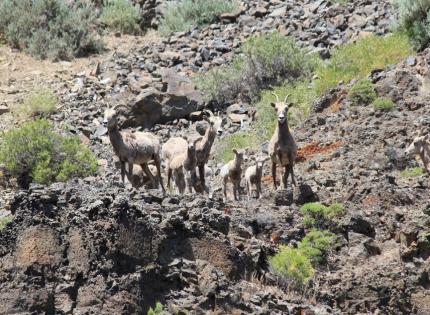
Townsend Ground Squirrel Monitoring: District 8 Wildlife Biologist Wampole and Assistant Wildlife Biologist Moore continue to survey for Townsend ground squirrel colony sites. Ground squirrels were once common. Washington Department of Fish and Wildlife has noticed declines in historically occupied sites. To better assess this, biologists have been working to assess historic site status and identify new locations of colonies to determine if breeding is occurring. Efforts to solicit public observations of these tailless ground squirrels are ongoing. If you see one please submit reports using WDFW’s ‘At-Risk’ Wildlife Observations form.

Providing Recreation Opportunities
Region 3 Special Permit Season: The Customer Service and Wildlife Program staff members addressed a record number of inquiries from hunters (in person, on phone, and by email) and they offered invaluable guidance to aid hunters in making informed choices regarding their applications for special hunts.
Providing Conflict Prevention and Education
Tree Removals During Nesting Season: Assistant District 8 Wildlife Biologist Moore has been called to address instances of tree removal involving existing nests. Initially, a western screech owl was found nesting within a tree that was slated to be removed. Moore inspected the tree cavity and set up a motion-activated trail camera to monitor activity. However, it was determined that the owl had vacated the area, thus alleviating concerns of ongoing nesting.
In another scenario, a local tree-cutting service was tasked with removing a potentially hazardous tree on private property. During the limb removal process, it was discovered that one of the tree's natural hollows served as a nest for several kestrel nestlings. Promptly recognizing the need for guidance, the company reached out to the Washington Department of Fish and Wildlife (WDFW) for advice. In accordance with the federal Migratory Bird Treaty Act, the company was instructed not to proceed with tree removal until the nestlings have fledged, ensuring compliance with legal protections for migratory birds.
Wenas Wildlife Area – Roza Posts and Cable: Wenas Wildlife Area Lands and Recreation Specialist Frame, Natural Resource Technician Janes, and Assistant Manager Taylor installed posts extending out from the gate blocking access to the Roza Road. There have been issues with people driving around the gate and illegally accessing the area. A cable will be strung along the posts to help prevent people from driving into the area.
Corral Canyon Elk Area Summer Bull Permits: District 4 Wildlife Conflict Specialist Hand monitored and coordinated damage prevention permit (DPP) hunts in elk area 3721. Ten bull elk have been harvested thus far. Non-lethal hazing in crop fields continues during nocturnal hours.
Kahlotus Deer Damage: District 4 Wildlife Conflict Specialist Hand inspected several wheat fields in the Kahlotus area that have historically received substantial deer damage. Heavy deer damage has occurred in a few areas, especially near remote locations near the breaks of the Snake River.
Richland Deer: District 4 Wildlife Conflict Specialist Hand responded to a call concerning an injured deer in Richland. While in route to the area the deer died from its injuries sustained in a vehicle collision along a very busy roadway. The young buck deer was transferred to a Washington Department of Transportation carcass pit.
Kittitas County Conflict: District 8 Conflict Technician Leuck and Conflict Specialist Wetzel hazed some elk from areas in Kittitas County. Elk ventured to areas in Thorp, Vantage, Kittitas, Badger Pocket, and Cle Elum mostly following migratory routes and visiting some crop fields and new seedings. Leuck and Wetzel also responded to several elk that were struck on I-90. Elk have been hazed away again from I-90 in some locations.
District 8 Conflict Specialist Wetzel responded to several calls about black bears that have been nuisances and have low fear of humans in a neighborhood in Hyak. Trapping has been underway.
Yakima County Conflict: District 8 Conflict Technician Leuck and Conflict Specialist Wetzel checked for elk in the Tampico and Cowiche areas and inspected fences in those locations. Elk appear to have moved up and away from the winter damage areas.
Bumping Lake Deer: District 8 Conflict Specialist Wetzel rescued a deer trapped in the spillway at Bumping Lake.
Conserving Natural Landscapes
Wallula Gap Vineyards Food Plot: Region 3 Private Lands Biologist Manderbach met with two landowners in Benton County to do a site visit for a potential food plot project. The main concern that brought the idea up is deer eating young grapes, and the landowners thought of implementing a food plot to attract the deer away from the grapes. They are also required to use water this summer and a food plot would be a great project to use extra water. In total there would be 130 acres to work with. Manderbach has been working with staff members from the Benton Conservation District to help with the implementation of the project. The timing of finding out about this idea was not ideal, but a temporary food plot may be implemented this year with a better native mix along with shrub rows being added in starting this fall.

Wenas Wildlife Area – Weed Control: Wenas Wildlife Area staff members have continued weed treatment throughout the wildlife area. The primary target for spot spraying with backpack sprayers has been whitetop, but Canada and Scotch thistle are still being found. Natural Resource Technician Janes sprayed the firebreaks and parking areas in the southern portion of the wildlife area to help hinder the movement of fires through the wildlife area.
Wenas Wildlife Area – Mowing: Wenas Wildlife Area Lands and Recreation Specialist Frame mowed the McCabe restoration site to knock down cereal rye in the area and prepare for weed spraying. Natural Resource Technician Stoltenow mowed around the Mellotte office and the Wenas Wildlife Area Headquarters to help reduce the risk of fires.
L.T. Murray Wildlife Area Quilomene Grazing: The bison are back on the Quilomene Unit leading to a heightened interest in figuring out some fencing issues in the Parke Creek drainage.

L.T. Murray Wildlife Area Relic Barbed Wire Cleanup: L.T. Murray Wildlife Area Assistant Manager Winegeart led a volunteer effort to remove old barbed wire from the Whiskey Dick Unit of the L.T. Murray Wildlife Area. The day was a great success with over a half mile of barbed wire being taken down and removed from the landscape.

L.T. Murray Wildlife Area Cole Creek Resource Protection: The L.T. Murray Wildlife Area crew placed 3,800-pound concrete blocks across an off-road trail some individuals had been using to go around the broken Cole Creek Bridge on the Yakima River Unit. Someone moved one of the blocks the first weekend after installation and more than a half dozen vehicles were seen and/or cited for driving around the blocks and subsequently through Cole Creek. An extra block and additional signage will be added soon.

Oak Creek Wildlife Area Volunteer Service Day: Oak Creek Wildlife Area Assistant Manager Charlet and 20 Rocky Mountain Elk Foundation volunteers used a combination of mechanical and chemical control to treat approximately 20 acres of land around Mud Lake. This area has a dense infestation of dalmatian toadflax with occasional Canada thistle, knapweed, and mullein plants found.
Oak Creek Wildlife Area Weed Control: Oak Creek Wildlife Area staff members have continued weed treatment throughout the wildlife area. The primary focus has been on the chemical control of Scotch thistle, but as time allows all species on the noxious weed list are controlled. Contractors have also started chemically controlling noxious weeds in various areas on the Oak Creek and Cowiche units, primarily focusing on Scotch thistle.
Sunnyside-Snake River Wildlife Weed Control: Sunnyside-Snake River Wildlife Area staff members have been busy applying herbicide to Scotch thistle, houndstongue, and other noxious weeds. Windy weather has delayed some of the herbicide applications. Staff members have also been cleaning litter and debris from wildlife area access sites.
Colockum Wildlife Area: Colockum Wildlife Area staff members ordered multiple dump truck loads of rock to be dumped into mudholes created by 4X4’s at Lily Lake. There is a long history of “mudding” at Lily Lake in the Stemilt Basin and they are attempting to discourage this by dumping sharp angular rock into the worst of the mudholes. Rock will be spread out to make mudding a little less attractive.
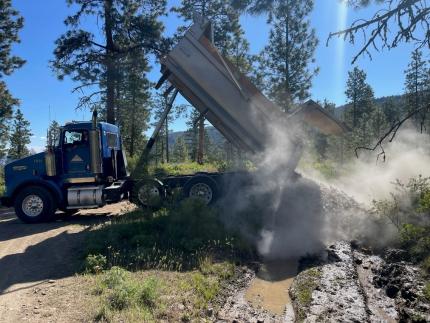

Providing Education and Outreach
Sacagawea Park Salmon Celebration: Region 3 Private Lands Biologist Manderbach led birdwatching walks for elementary classes as part of the Franklin Conservation District’s Salmon Celebration at Sacagawea Park. Each class was able to see a handful of different bird species while following general birdwatching rules of remaining quiet and moving slowly. Many of the students were very excited and some were even pointing out birds for their classes. The highlight of the day was a raccoon peeking its head out of a tree cavity that a few of the classes were lucky enough to see.
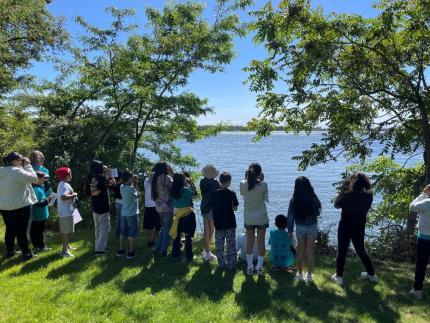

Sunnyside-Snake River Wildlife Area Outreach: Sunnyside-Snake River Wildlife Area Manager Kaelber and Natural Resource Technician Edwards taught students attending Salmon Celebration about the wildlife found in the State of Washington. Students were able to touch and feel various animal pelts, antlers, and skulls.
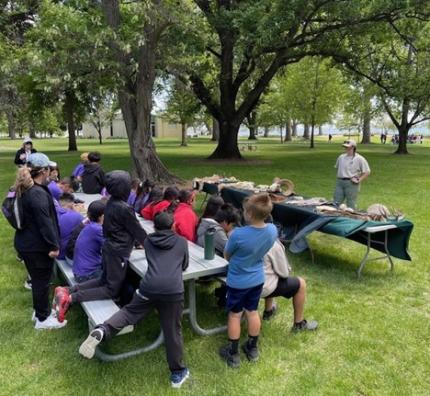
Mesa Elementary Ecology Day: Region 3 Private Lands Biologist Manderbach, with the help of an environmental educator from the Franklin Conservation District, worked a station at the annual Ecology Day at Mesa Elementary. Students attended 30-minute stations throughout the day with different presentations and activities centered around ecology and the environment. This year Manderbach put on a seedball workshop while speaking about wildflowers and pollinators. Each student crafted three to five seedballs using a compost/clay powder/water/wildflower seed mix. Some of the species in the mix included western yarrow, Lewis blue flax, arrowleaf balsamroot, and Munro’s globemallow.

Wenas Wildlife Area – Legoman Kiosk: Wenas Wildlife Area Assistant Manager Taylor, Lands and Recreation Specialist Frame, and Natural Resource Technicians Stoltenow and Janes installed a kiosk and reader-board in the Legoman portion of the wildlife area. The reader-board shows information regarding the proper usage of green dot roads and will have a green dot map in the future. The kiosk has information on regulations for recreational use of the wildlife area as well as information about the wildlife area.
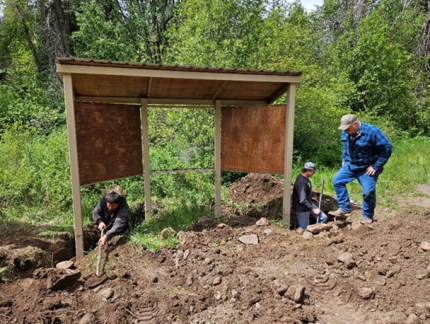

Conducting Business Operations and Policy
Wenas Wildlife Area- RCO Grant: Wenas Wildlife Area Manager Gray and Habitat Specialist Miller presented a proposed project on the Wenas Wildlife Area to The Recreation and Conservation Office (RCO). Grants from RCO help to supplement acquisition funding for the wildlife area as well as contribute toward essential conservation work.
Other
District 4 Burrowing Owl Supplies: District 4 Wildlife Biologist Fidorra coordinated with the Blue Mountain Audubon Society chapter to purchase supplies for U.S. Fish and Wildlife Service artificial burrows for burrowing owls. Fidorra received and delivered supplies to the Hanford Reach National Monument staff members.

Oak Creek Wildlife Area Abandoned Trailer: Oak Creek Wildlife Area Assistant Manager Charlet found an abandoned trailer on the Cowiche Unit after the long Memorial Day weekend. Law enforcement was contacted and were very responsive and helpful in working through the process to resolve this situation.